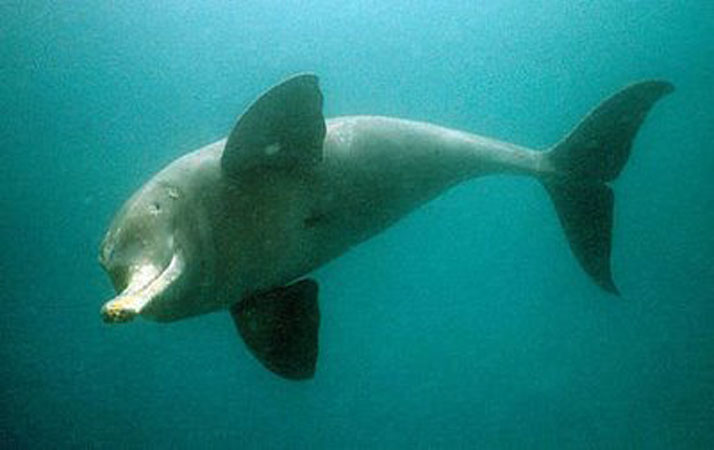Indus-Blind dolphin


Various reports reveal that animals are disappearing at hundreds of times more than the traditional (normal) rate, and primarily because their habitats and abodes are shrinking at an alarming pace.
The Indus River dolphin is additionally referred to as the blind dolphin which has been marked as endangered by the International Union for the Conservation of Nature (IUCN), Red List of Threatened Species (RLTS).
According to IUCN a history background document, the Indus river dolphins’ origin is believed to have been linked back with ancient Tethys Sea.
With the passage of time, the sea was dried up 50 million years ago (approximately) and the dolphins were forced to push and adapt their survival in the only remaining habitat, rivers.
Since then most dolphins are confined to a stretch of 750 miles in the river Indus and divided into isolated populations amid six barrages. The dolphins have to adapt to life in the muddy river water, and are believed since then to be functionally blind. Without eyes the rare species of blind dolphins rely on echolocation to communicate, navigate, and hunt prey including catfish, prawns, and carp.
The all existing dolphin species remain in the lower downstream reaches of the Indus River in Pakistan, while a small isolated and specific population of around 30 dolphins exists in the Beas River, in India, it says.
After launching various communities based conservation initiatives, the World Wide Fund for Nature (WWF), during 2017 had conducted a survey, which revealed that, after a successful community based contribution, a considerable population expansion of the endangered Indus River dolphin was witnessed.
According to this month-long survey report there are approximately 1,816 Indus River dolphins in Pakistan.
This population is 50 percent more than the number 1,200 dolphins which were calculated (estimated) after WWF’s first census of the mammal in 2001, when the species appeared to be heading for extinction.
International Union for Conservation of Nature (IUCN), country representative, Mahmood Akhtar Cheema told APP that due to the construction of various barrages and hydro power projects along mighty Indus, the downstream dolphins are currently confined to just 20 percent of their natural habitat range.
Definitely, despite increase in their population, the developmental projects and agricultural activities could peril the mammal species, adding, their population would gradually decline due to worsening water and plastic pollution, stranding of the dolphin in irrigation canals, poaching and some time accidentally getting caught in fishermen’s nets.
To a query, Cheema said that to help conserve the species, IUCN, Sindh-Punjab wildlife departments and WWF had spearheaded and adopted an innovative and collaborative effort by initiating integrated research and effective law enforcement through communities’ engagement.
Meanwhile, according to World Wide Fund for Nature- Pakistan data, annually around more than eight million tonnes of plastic entered various oceans globally, which meant plastic accounted for 60 to 80 per cent of global marine garbage.
Regarding plastic pollution, the mighty Indus River falls on the second number of the most plastic polluted rivers in the world, while the first, third and fourth rivers regarding this pollution belong to China.
The WWF detailed-data reveals further, the PET (polyethylene terephthalate), a plastic which is widely used for packing food, soft drinks, beverages, water and juices, is not biodegradable and contaminates water sources and its ways and causes death of river and marine life when the animals ingest it.
Uzma Khan, director of biodiversity at WWF Pakistan told APP that the Indus river blind dolphin is an endangered species of the fresh waters and is only found in the Indus river system, restricted from Chashma barrage (in Punjab) to to Kotri barrage (in Sindh) in the river stretch of approximately 1300 km.
WWF has conducted some tissue sample analysis of the species, which has shown high levels of heavy metals in the tissues of the mammals, adding, “We have also found pesticides residues in both Indus dolphin and fish samples”.
She said that various studies of other species, showed that such contaminants can cause decline in the breeding potential of a population, however this has not been seen in the Indus river dolphin. “We have had a few cases where pesticides poisoning causes the mortality of the dolphins, largely such activities are carried out to either kill freshwater turtles for illegal trade or to kill fish, and dolphins are lost as a non-targeted-species”, Uzma explained while replying to a query.
WWF-Pakistan with its partners, Sindh and Punjab Wildlife Departments has been monitoring the population by using standardised survey techniques since 2001, and, “We have seen an increase in the population from 1200 in 2001 to 1900 in 2018,” Uzma Khan added.
However, all this population is restricted in a small stretch of the river and water diversion for agriculture causes very low dry season flow, making these dolphins vulnerable to mortalities in fishing nets. Some of the potential habitat downstream of Sukkur barrage has dry stretches because not enough water is flowing downstream.
WWf has already set-up a dolphin monitoring network in collaboration with local communities and a round the clock phone helpline has also been established, she informed.
A latest survey, conducted by the WWF on dolphin census revealed there are 571 dolphins between Taunsa and Guddu stretch (approximate 354 km) while Taunsa – Chashma section contains around 170 dolphins. Dolphins do come near Taunsa barrage themselves but more sightings begin about 10 km up or downstream the barrage, she added.
She emphasised that citizens should reduce the use of plastic to zero, and promote plastic-free practices across the river side and coastal spots, to save the dolphins and marine life.
Leave a Comment